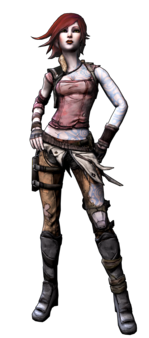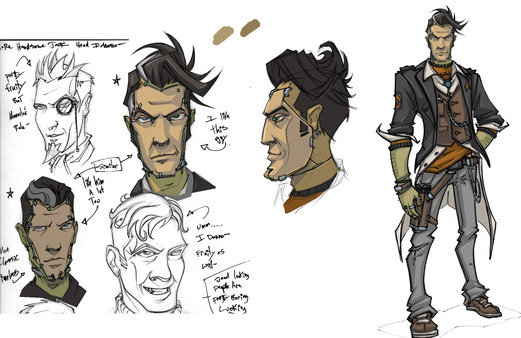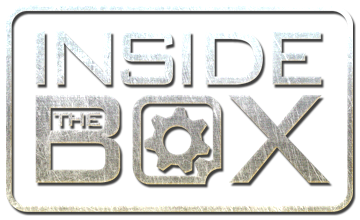
Inside the Box serves as a forum for individuals involved in the production of Gearbox Software content to share personal motives, methods, process and results. Gearbox Software projects are created by a diverse range of individuals spanning a spectrum of different backgrounds, interests, objectives and world views. The views and opinions expressed in this article are those of the author and do not necessarily reflect the official policy or position of Gearbox Software or any of its individual members outside of the author.
Hey all,
A little while back I wrote an article about the process of creating Handsome Jack, the villain of Borderlands 2. I ended my little writeup asking if there as anything else you wanted to hear about, and figured I’d spend another article responding to some of your questions and curiosities.
WARNING: THE EVENTS OF BORDERLANDS 2 ARE DISCUSSED BELOW
I also have quite a few people who have said they prefer Lilith to killing jack, vs the vault hunter. What made you decide to give that option rather than just decide it up to the player which choice of weapon they would like to blast his handsome face off with? – Jill B.
From the very get-go, I really wanted Jack to die from a single bullet from the player’s gun, Call of Duty style. I always find protracted boss battles with archenemies really unsatisfying – once you put a single bullet into someone and they don’t die, they stop feeling like a character and start feeling like A Videogame Enemy. I derived way more satisfaction from one-shotting the baddie of Modern Warfare than I did killing Atlas in BioShock (and I say that as someone who LOVES BioShock and is currently sitting next to that game’s lead designer and please don’t kill me Paul).
For a long time, in fact, the plan was to not fight Jack at all – that he’d be physically connected to The Warrior or something (either by Siren magic or techy nonsense) and basically act like a glorified crit spot. After killing The Warrior, he’d tumble off its corpse, nearly dead himself, and you’d deliver the coup de grace.
When it came time for Josh Jeffcoat and Robert Anderson to design the endboss fight, however, they discovered that this added a needlessly large amount of complexity to what should have been a fun, straightforward boss fight. Rather than integrating Jack and the Warrior into a single combat, then, they separated Jack into a sort of “appetizer” boss fight – an easier encounter before the epicness of the Warrior.
This caused a new problem, however: Jack’s the entire goal of the plot. Once he’s dead, the story should end – if Jack dies, the Warrior will feel irrelevant. To fix this new problem, we fell back on an old, admittedly pretty unfortunate videogame cliché: the ol’ “you have knocked me down to 10% health, so I will start a cut scene where I manage to escape momentarily” trick. We kept the Jack fight at the beginning, then had you kill the Warrior, and then reintroduced Jack as a violent little cherry on top of your boss fight sundae.
Which led to a new problem. Randy Pitchford and Brian Martel saw the boss fight and pointed out that, as implemented, you technically murder Jack at the game’s end. Borderlands is a violent game, sure, but all the violence you commit is technically justifiable as self-defense. With Handsome Jack, however, that justification went away: he was kneeling, cursing your name, implicitly begging for his life. There’s no reason (narratively, at least) that the player or Lilith couldn’t just arrest him, or knock him out.
Narratively, we knew that the player had to be given the opportunity to kill Jack in their own way. They’ve spent the entire time trying to find this guy, and we really wanted the player to take the bastard out in whatever way suited them (we fantasized about people shooting Jack with the very first pistol they got in the game, a la Pirates of the Carribbean, or using Roland’s assault rifle quest reward to avenge him). But we also didn’t want to force the player to act like a creepy-ass murderer.
Enter: Lilith. After some discussion, we decided to give the player a choice: if they wanted to murder Jack themselves, they could. If they felt morally shaky about murdering Jack, they could let Lilith do it (which is still kind of morally shaky, but in a less personally upsetting way).
Amusingly, I’ve seen some fans interpret this choice opposite of how we intended; they feel that it’ll be more brutal and vengeful for Lilith to kill Jack. I’ve seen some people say they chose Lilith because she “deserves” to get her personal vengeance, or that Lilith’s crazy Siren magic could probably cause Jack more pain before he died. I’ve only heard one or two people say that they let Lilith kill Jack because they felt morally awkward about doing it themselves.
I would love to hear more about how you brought his character to life on the screen. Why did you design him to look the way he does – for example, his differently colored eyes? – Taylor D.
At the risk of speaking for Scott Kester (lead concept artist) and Jeramy Cooke (art director), Jack got many of his cool details (the mask, the differently colored eyes) to make him stand out and feel unique.
When it came time to design Jack’s concept, Paul and I gave the art team a bunch of really difficult, weird thoughts on where we imagined this character sitting. He’s like the hero of a different videogame! He’s arrogant and funny, but also smart! He’s the CEO of a corporation, but he’s really down-to-earth! He thinks he’s a hero, but he’s basically space-Hitler! And he’s really handsome, like Han Solo!
Jack’s visual design was an attempt to address all those aspects of his character. His layered clothing shows that he’s quasi-businesslike, but also casual; his differently-colored eyes make his face asymmetrical (Scott Kester is a huge fan of asymmetry in Borderlands character designs); his mask draws attention to his handsomeness, but in a very down-and-dirty, Borderlands-y kind of way that inspires curiosity.
When you were hammering out what made this character tick, was the premise that Jack actually believes things he says to the player; or is the idea that he’s perfectly aware of what’s real and what isn’t, and his more reality-challenged dialogue is for the benefit of some hypothetical other audience (like his staff, posterity or it will be a great clip for the press release when that pesky vault hunter buys it)? – Patrick Q.
We always felt like Jack believed everything he said, even when he lied to himself (about his treatment of Angel, for instance). It was important to us that Jack think of himself as a hero, no matter how bad things got. Given that the first game opens with a song that implicitly refers to the game’s protagonists as “the wicked,” and given that you kill and corpse-loot millions of things on Pandora, we wanted to at least partially acknowledge the inherently antiheroic nature of what you do as a Borderlands player. Making Jack a self-styled hero gave us an opportunity to deal with that theme directly: when he says that Pandora would be better off without Vault Hunters, we wanted you to wonder – just for a second – if he might actually be right.
That said, we still wanted to make Vault Hunters the “good guys,” if only in comparison to Handsome Jack. This PopMatters article – one of my favorite pieces of writing on Borderlands 2 – nicely encapsulates the stuff we (if only subconsciously) wanted to accomplish with Jack and the Vault Hunters.
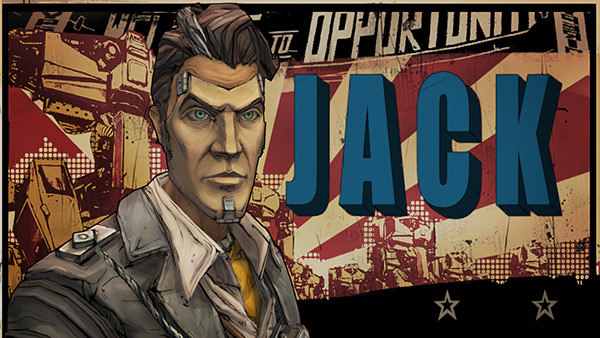
I’m also curious as to the relationship between Mr. Burch and Mr. Clarke and how it shaped Jack as a whole. Did Mr. Clarke add his own style that Mr. Burch had to adjust to, writing wise? Was their conflict between the pair concerning what Jack should or should not say? – Brian L.
There was never any conflict. From the first moment that we, by chance, grabbed Dameon after one of his Dragonball sessions while we were in the same studio, he brought an incredible amount of humor and character to Jack. He immediately got the character, and quickly started adlibbing and improving what was on the page (again, the frigging “these pretzels suck” thing was all him).
[Please talk about how you tried to work Jack into the BL1 Angel subplot, also I have the best name ever] – Ultima K.
Part of our job with Borderlands 2 consisted of wrapping up loose ends from Borderlands 1. Primarily, those loose ends revolved around the Vault and Angel. We didn’t want to tie up the Vaults, because that’s an all-encompassing aspect of the universe’s lore and we still have mysteries to reveal and stories to tell about them.
We did, however, feel as if we needed to explain Angel – not because she’s less important than the Vaults, but because she drew so much attention to herself and inspired so much curiosity. I remember how I felt upon beating BL1: who was the Angel chick? Why was she helping me? Why did she look like a real-life person? What’s her connection to that Hyperion satellite orbiting the planet?
In truth, the BL team didn’t quite know the answers to any of these questions when they shipped the game. Many devs had ideas, of course, but there was no Master Plan regarding Angel.
So, funny story – you know why Hyperion is the main baddie in Borderlands 2? Why roughly 30% of the game includes Hyperion loaders, and why we go to Hyperion-centric locales, and speak to Hyperion characters about Hyperion problems?
It’s not because we had something important to say about Hyperion. It’s not because we felt that Hyperion’s flavor perfectly encapsulated the evil corporate disingenuousness that the story inherently needed.
We chose Hyperion because the Angel satellite at the end of BL1 was a Hyperion branded satellite.
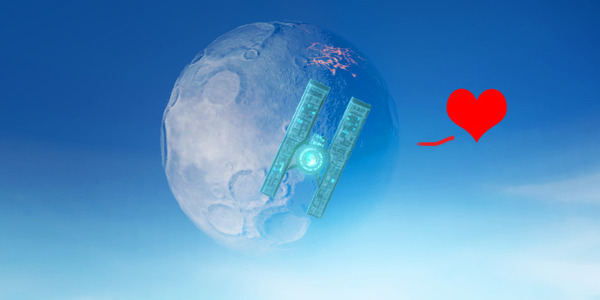
That’s it. One little detail from BL1 resulted in a cascade of huge choices that echoed all throughout BL2.
That said, combining our new story (“kill this one dude named Handsome Jack or whatever he ends up being called, by the way we definitely can’t ship the game with him being called Handsome Jack because that’s just a Doctor Who reference I pulled out of thin air”) with answering the old BL1 questions was one of the trickiest narrative problems Paul and I tried to solve during preproduction.
We needed to solve the Angel problem. Why was she displayed to the player as a real person, who was she, and why did she so desperately want you to open the Vault in BL1? Jeramy Cooke had suggested we make her a secret Siren, and we really liked that, but we still had to find an explanation that (A) felt cool, (B) felt relevant to Angel’s actions in BL1, and (C) also felt relevant to the player’s current actions in BL2.
It took a crapload of brainstorming and tossing ideas away until we landed on making Angel Jack’s daughter. This, to some extent, solved all our narrative problems: it made Angel relevant to Jack and the story of BL2, and – surprisingly – meant that Angel’s words and deeds in BL1 were also technically driven by Handsome Jack, keeping him in the forefront of the story even when we spent time talking to or about Angel.
Granted, it unfortunately also resulted in Angel being the most damseled damsel in the history of damsels. Which, you know. Damn. But still.
Anyway, that’s the majority of the questions I received that didn’t consist of “what’s under Jack’s mask” or “what happened to Jack’s wife”. If you have any feedback on this article or what you want to see here on Inside the Box please let us know at [email protected], hit up our forums or tweet me @reverendanthony


